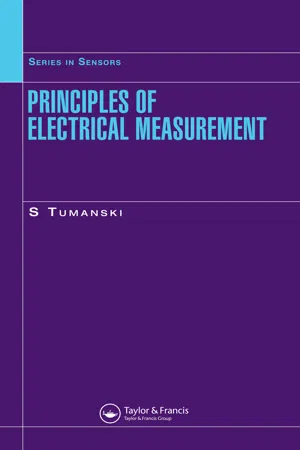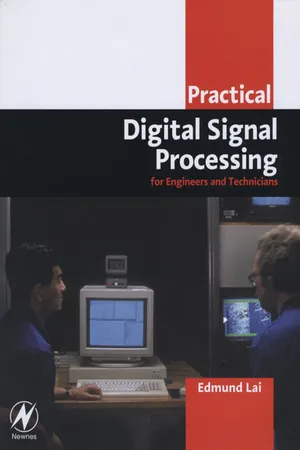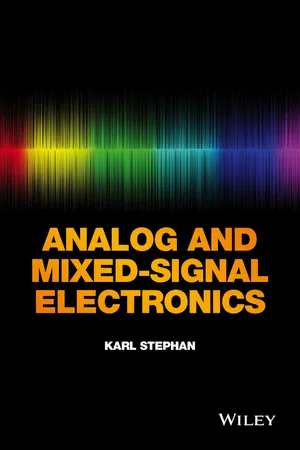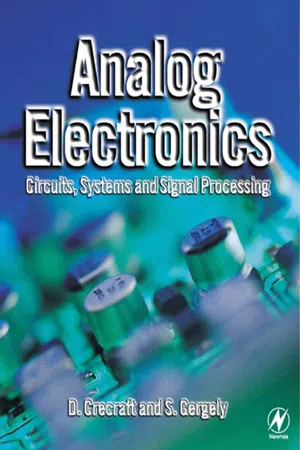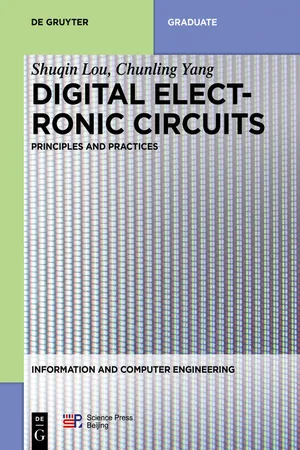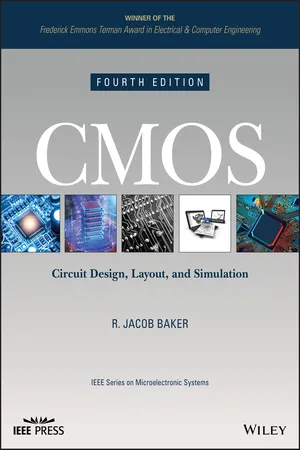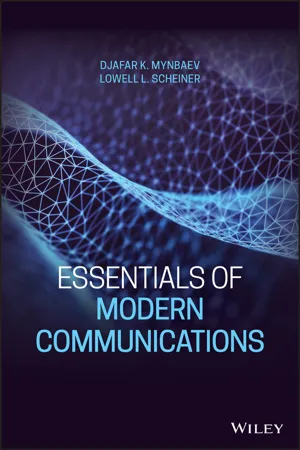Physics
Converting Analogue to Digital
Converting analogue to digital involves the process of representing continuous, analogue signals as discrete, digital values. This is typically achieved through sampling the analogue signal at regular intervals and quantizing the sampled values into binary numbers. The resulting digital representation allows for more efficient storage, transmission, and processing of the original analogue information.
Written by Perlego with AI-assistance
Related key terms
Related key terms
1 of 4
Related key terms
1 of 3
12 Key excerpts on "Converting Analogue to Digital"
- eBook - ePub
- Slawomir Tumanski(Author)
- 2006(Publication Date)
- CRC Press(Publisher)
5 Digital Processing of the Measurement Signals5.1. ANALOGUE-TO-DIGITAL CONVERTERS
5.1.1. Sampling, quantization and coding of signals
The technical world is becoming more and more digital because digital signals are very convenient for information processing. However, most physical phenomena are analogue and the sensors measure analogue quantities. For that reason, the digital signal processing is often realized in the following sequence: conversion of the analogue signal to digital form digital signal processing conversion of the digital signal back to the analogue one. The conversion is realized by the analogue-to-digital converters ADC while the reverse process is realized by digital to analogue converters DAC.The analogue signals are of continuous time – the value of such signal is determined in every instant of time. An example of the analogue signal is presented in Fig.5.1 a. The conversion of the analogue signal x(t) to the digital form is realized in such a way that in assumed moment of time the value of the signal x(n) is determined and represented by a number. We can say that the digital signal is determined in discrete time, which means that the value of the signal is known only in selected moments. Usually the discrete time is realized by collecting the samples of the analogue signal at the constant interval called the period of sampling Ts (Fig.5.1 b).Figure 5.1 . The analogue signal (a) and its conversion to the discrete one (b)The process of collection of the samples is called the sampling process of analogue signals. The frequency fs =1/Ts is called the sampling frequency and it is described in Hz or SPS – samples per second. The process of determination of the digital value of the samples is called the quantization - eBook - ePub
Electronics
from Classical to Quantum
- Michael Olorunfunmi Kolawole(Author)
- 2020(Publication Date)
- CRC Press(Publisher)
7 Data Conversion ProcessThere is a strong motivation behind exploring a novel frontier of data processing that could benefit from cutting-edge miniature and power-efficient nanostructured silicon photonic devices. Recent example is photonic accelerator (PAXEL)—a processor that can process time-serial data either in an analog or digital fashion on a real-time basis [1]. Data processing is a way of converting data into a machine-readable form using a predefined sequence of operations. Communications signals can be analog or digital, and information can be transmitted using analog or digital signals. Analog signals are continuously changing in time (or frequency), while digital signals are discrete in time and amplitude. Interchangeability of information transfer allows the development of conversion processes without loss of detail. The challenge is to achieve a high sampling rate and high conversion accuracy in the presence of component mismatch, nonlinearity errors, and noise. Although the electronic circuits required to do this conversion processing can be quite complex, the basic idea is fairly simple. The basic concepts of data conversion and their inherent errors, as well as the choice of the converter types that strongly influence the architecture of the overall system, which are fundamental to the continuing revolution in information technology and communication systems, are explained in this chapter.7.1 Introduction
Analog signals are continuously changing in time. By “continuous” it means that no matter when one looks at the signal, there is a voltage or current value that represents the instantaneous value of the signal. Music and speech are examples of analog signals that vary continuously in frequency (or time), amplitude, or both. Figure 7.1 - eBook - ePub
- Edmund Lai(Author)
- 2003(Publication Date)
- Newnes(Publisher)
2Converting analog to digital signals and vice versa
2.1 A typical DSP system
In the previous chapter, we mentioned that some signals are discrete-time in nature, while others are continuous-time. Most of the signals encountered in engineering applications are analog. In order to process analog signals using digital techniques, they must first be converted into digital signals.Digital processing of analog signals proceeds in three stages:• The analog signal is digitized. Digitization involves two processes: sampling (digitization in time) and quantization (digitization in amplitude). This whole process is called analog-to-digital (A/D) conversion.• The appropriate DSP algorithms process the digitized signal. • The results or outputs of the processing are converted back into analog signals through interpolation. This process is called digital-to-analog (D/A) conversion.Figure 2.1 illustrates these three stages in diagram form.Figure 2.1 The three stages of analog–digital–analog conversions2.2 Sampling
We shall first consider the sampling operation. It can be illustrated through the changing temperature through a single day. The continuous temperature variation is shown in Figure 2.2 . However, the observatory may only be recording the temperature once every hour.Figure 2.2 Temperature variation throughout a dayThe records are shown in Table 2.1 . When we plot these values against time, we have a snapshot of the variation in temperature throughout the day. These snapshots are called samples of the signal (temperature). They are plotted as dots in Figure 2.2 . In this case the sampling interval, the time between samples, is two hours.Table 2.1 Temperature measured at each hour of a dayHour Temperature 0 13 2 12 4 10 6 11 8 13 10 16 12 19 14 23 16 22 18 20 20 16 22 15 24 12 Figure 2.3 shows the diagram representation of the sampling process.Figure 2.3 The sampling processThe analog signal is sampled once every T - eBook - ePub
- Karl Stephan(Author)
- 2015(Publication Date)
- Wiley(Publisher)
The point of this short detour into physics is to show that the traditional distinction between analog and digital signals is more apparent than real. Nevertheless, many signals are most easily acquired or transmitted in analog form, and it is therefore necessary to convert between its analog and digital representations. We will begin with a discussion of the basics of analog-to-digital conversion, followed by examples of commonly used circuit types.8.3 BASICS OF ANALOG-TO-DIGITAL CONVERSION
We have already stated that a band-limited analog signal can be completely reconstructed from samples taken at a sufficiently frequent rate in accordance with the sampling theorem. Sampling by itself is not an inherently digital operation, however. The samples can be preserved and transmitted in their original analog form without ever converting them into digital numbers. However, the customary procedure is to first sample an analog signal at a fixed rate fS and then convert each sample into its binary representation.8.3.1 Quantization Error
The resolution of an analog-to-digital converter (henceforth abbreviated as ADC) is related to the number of meaningful bits N that it can produce. Not including the sign bit (which, if used, indicates whether a voltage is positive or negative), an N-bit binary number can represent any of 2N discrete voltage levels. So a 1-bit converter (there are actually uses for such a rudimentary device) can distinguish between 21 = 2 levels, while a 16-bit converter can handle 216 = 65,536 levels, and each additional bit doubles the number of levels available. But even a 16-bit converter cannot represent arbitrary voltage levels perfectly, and this unavoidable error in ADCs is called quantization error or quantization noise.A simple graphical example of quantization error is illustrated in Figure 8.6 , which shows what would happen if we digitized the range of voltages from 0 to 1 V with both a 1-bit and a 4-bit ADC. Let VA designate the digitized approximation to the input voltage VIN . The error voltage VE - eBook - ePub
Analog Electronics
Circuits, Systems and Signal Processing
- David Crecraft, Stephen Gergely(Authors)
- 2002(Publication Date)
- Butterworth-Heinemann(Publisher)
7Analog-to-digital and digital-to-analog conversion
7.1 Introduction
An analog quantity, or variable, is one that can assume any value between its maximum and minimum limits and one which exists continuously all the time. Most of the physical quantities in nature are analog quantities, such as temperature, pressure, light intensity, current, etc. A digital quantity is best thought of as one which is represented as a series of numbers. At this point in the development of technology digital electronics is the best way one has for the processing of information and for its transfer both in space, (telecommunication) and in time (storage). So if, for example, one wishes to transmit speech via a telephone network which uses digital technologies then the analog electrical signals corresponding to the pressure variations of sound must be converted to the digital form. Similarly, at the receiving end the digital signals have to be converted back to their analog equivalent to reproduce the sound of the original speech. So, analog-to-digital (A to D or A–D) and digital-to-analog (D to A or D-A) conversion forms an important part of many of the processes used in industrial and consumer equipment.7.2 Quantization
No matter how long the numbers are representing a digital quantity, there are only a finite number of them. Therefore the quantity they represent is restricted to a finite number of values or quanta. The process called quantization restricts the infinite number of possible values of an analog quantity to the finite number which can be represented digitally. Figure 7.1 illustrates this. The number of these levels is determined by the number of digits used to represent them. This is expressed in terms of binary numbers since the output of A–D converters is in this form. So, an n bit converter has 2n quantization levels between the minimum and the maximum of the input range, or full scale (FSD). Its resolution (defined as the smallest change of input which is detectable at the output) is therefore 1 in 2n . So, a 10 bit converter has 210 = 1024 levels corresponding to a resolution of 1 in 1024 or 0.098% FSD. Note that resolution and accuracy are different measures of performance. Accuracy - eBook - ePub
Television Technology Demystified
A Non-technical Guide
- Aleksandar Louis Todorovic(Author)
- 2014(Publication Date)
- Routledge(Publisher)
digital-to-analog (D/A) conversion . All these A/D and D/A processes have to be as transparent as possible in order to ensure a faithful reproduction at the end of the chain of the sounds and sights that were really present in front of the cameras and microphones.5.2 Analog-to-Digital Conversion
The A/D conversion process consists of three steps:- sampling
- quantizing
- coding
The sampling process means the taking of a number of sample values at evenly spaced intervals across a continuous signal. As shown in Figure 5.2 , a higher-repetition frequency of the sample-taking process will result in better assessment and, later, representation of that signal. To sample analog electric signals that change over time means to take as many samples in a unit of time as is workable. An insufficient number of samples leads to an inadequate assessment and possible misinterpretation of the original form of the sampled signal, but too many samples can lead to an unnecessary accumulation of redundant data, thus wasting time and resources. For example, measuring the outside temperature two times a day, for example, at 8:00 a.m. and 8:00 p.m. and obtaining identical values in each sample could lead to an erroneous conclusion that the temperature was constant for 24 hours while in reality it was probably higher at noon and lowerFigure 5.2 Sampling.during the night. The insufficient number of sample values results in the wrong assessment of the measured phenomena. On the other hand, if measurements are taken every 10 seconds, they will provide 8,640 values for one day, of which a good deal will be redundant as it takes longer that 10 seconds for there to be a noticeable change in the outside temperature. Subsampling leads to an erroneous interpretation of the observed phenomena, while oversampling - eBook - ePub
Digital Electronic Circuits
Principles and Practices
- Shuqin Lou, Chunling Yang(Authors)
- 2019(Publication Date)
- De Gruyter(Publisher)
11 Analog-to-digital and digital-to-analog converter11.1 Introduction
With the rapid development of digital technology, digital technology has already been applied to a wide range of areas besides computer system. Such applications include communication systems, radar, navigation and guidance systems, military systems, medical instrumentation, industrial process control, and many others. However, digital circuits and digital systems deal with digital quantity. From physics point of view, a digital quantity is the one having a discrete set of values. Most things that can be measured quantitatively in nature with analog form. In order to process these analog quantities with digital technique, it is necessary to convert the analog quantity to a digital one. The device that converts an analog signal to a digital signal is called the analog-to-digital converter (ADC). Moreover, most electronic instruments are driven by analog signals and thus the processed digital quantity must be converted back to analog signal to drive the electronic equipment. The circuit that converts the digital signal to an analog signal is called the digital-to-analog converter (DAC). This chapter first introduces the basic concepts and then the operating principles of DAC and ADC. Several typical integration DAC and ADC chips and their applications are also covered.The objectives of this chapter are to- – Explain how analog signals are converted to digital forms
- – Describe the sample process
- – State the purpose of digital-to-analog conversion
- – Explain the operating process of several types of DACs
- – State the purpose of analog-to-digital conversion
- – Explain the operating process of several types of ADCs
11.2 Digital-to-Analog Converter (DAC)
In electronics, a digital-to-analog converter (DAC, D/A, or D-to-A) is a circuit that converts a digital signal into an analog signal. DAC is an important part of a digital processing system. After the digital data are processed, they need to be converted back to analog form. In fact, there are several types of DACs. This section mainly introduces two types of DACs: binary-weighted-input DAC and the R /2R - eBook - ePub
Embedded Digital Control with Microcontrollers
Implementation with C and Python
- Cem Unsalan, Duygun E. Barkana, H. Deniz Gurhan(Authors)
- 2021(Publication Date)
- Wiley-IEEE Press(Publisher)
The user may have an analog controller working as desired which has been designed beforehand. We may want to represent it in digital form as code. Hence, we can duplicate the existing analog controller in digital form such that no analog parts are needed for its implementation. This way, we can benefit from the advantages of digital domain. In a similar manner, most existing systems to be controlled are also in analog form. We may need their digital representations for control operations. Therefore, it becomes a necessity to bridge analog and digital domains. To do so, we will focus on methods to represent an analog system in digital form in this chapter. At the end of chapter, we will also provide a practical application emphasizing all the methods considered here.5.1 Converting an Analog Signal to Digital Form
Analog to digital conversion (ADC)operation should first be understood by mathematical derivations. Then, the reader should learn how to realize the ADC operation in practice. Therefore, we start with the mathematical derivation of ADC followed by its implementation via Python and C languages in this section.5.1.1 Mathematical Derivation of ADC
Before explaining ADC, we should inform the reader that we will be using the discrete-time signal representation introduced in Chapter 4 in mathematical derivation. As a reminder, the discrete-time signal lies between analog (continuous-time) and digital signal representations. The distinction between discrete-time and digital signals is as follows. The discrete-time signal samples may take real (unlimited) values. On the other hand, the digital signal samples can only take limited values.Let us start with the analog signal . Assume that, we want to represent it in digital domain. Therefore, we will need samples of the analog signal in time. This operation is well established by the sampling theorem(Oppenheim and Schafer 2009 ). Although mathematical derivation of this theorem is beyond the scope of this book, we briefly explain its working principles. To do so, we should first introduce the impulse signal, , defined in continuous-time. This is a signal with amplitude going to infinity and width shrinking to zero as . For all other index - eBook - ePub
CMOS
Circuit Design, Layout, and Simulation
- R. Jacob Baker(Author)
- 2019(Publication Date)
- Wiley-IEEE Press(Publisher)
This example illustrates the main differences between analog and digital signals. Whereas the analog signal in Fig. 28.1 a is continuous and infinite valued, the digital signal in (b) is discrete with respect to time and quantized. The term continuous-time signal refers to a signal whose response with respect to time is uninterrupted. Simply stated, the signal has a continuous value for the entire segment of time for which the signal exists. By referring to the analog signal as infinite valued, we mean that the signal can possess any value between the parameters of the system. For example, in Fig. 28.1 a, if the peak amplitude of the sine wave was +1V, then the analog signal can be any value between –1 and 1 V (such as 0.4758393848 V). Of course, measuring all the values between –1 and 1 V would require a piece of laboratory equipment with infinite precision. The digital signal, on the other hand, is discrete with respect to time. This means that the signal is defined for only certain or discrete periods of time. A signal that is quantized can only have certain values (as opposed to an infinitely valued analog signal) for each discrete period. The signal illustrated in Fig. 28.1 b illustrates these qualities. 28.2 Converting Analog Signals to Digital Signals We have already established the differences between analog and digital signals. How is it possible to convert from an analog signal to a digital signal? An example will illustrate the process. Where you live the temperature in the winter stays between 0° F and 50° F (Fig. 28.2 a). Suppose you had a thermometer with only two readings, hot and cold, and you Figure 28.2 (a) An analog signal representing the temperature where you live and (b) a digital representation of the analog signal taking one sample per day with two quantization levels. wanted to record the weather patterns and plot the results - eBook - ePub
- James D. Broesch(Author)
- 2008(Publication Date)
- Newnes(Publisher)
Chapter 2. The Analog-Digital Interface
Definitions
In most systems, whether electronic, financial or social, the majority of problems arise in the interface between different subparts. This is also true for digital signal processing systems. Most signals in real life are continuous in amplitude and time—that is, analog—but our digital system is working with amplitude- and time-discrete signals, or so-called digital signals. So, the input signals entering our system need to be converted from analog to digital form before the actual signal processing can take place.For the same reason, the output signals from our DSP device usually need to be reconverted back from digital to analog form, to be used in, for instance, hydraulic valves or loudspeakers or other analog actuators. These conversion processes between the analog and digital world also add some problems to our system. These matters will be addressed in this chapter, together with a brief presentation of some common techniques to perform the actual conversion processes.First we will define some of the important terms encountered in this chapter. Sampling is the process of going from a continuous signal to a discrete signal. An analog-to-digital converter (ADC) is a device that converts an analog voltage into a digital number. There are a number of different types, but the most common ones used in DSP are the successive approximation register (SAR) and the flash converter. A digital-to-analog converter converts a digital number to an analog voltage. All of these terms will be further explained as we move through the material in this chapter.Sampling and Reconstruction
Recall that sampling is how we go from a continuous (analog) signal to a discrete (digital) signal. Sampling can be regarded as multiplying the time-continuous signal g(t) with a train of unit pulses p(t) (see Figure 2.1 )(2.1) - eBook - ePub
- Djafar K. Mynbaev, Lowell L. Scheiner(Authors)
- 2020(Publication Date)
- Wiley(Publisher)
In Chapter 3, we discussed why it is necessary to prepare analog information for digital transmission and how to do so. In Section 3.1, we learned how to code characters (logical information) into binary words and how to encode those 1s and 0s into electrical or optical pulses. In Section 3.2, the parameters of a digital signal and their relationship with the characteristics of digital transmission were discussed. Though it seems that Chapter 3 has covered digital transmission in its entirety, one important aspect remains to be explored: Suppose we obtain information in the form of an analog signal. How is this handled electronically? Consider the work of your mobile phone, for example: Your voice is converted into an analog electrical signal by a microphone and this signal is sent out by your phone in digital format. Thus, the conversion of an analog electrical signal into a digital signal occurs within the mobile phone, and this is only one example of this kind of conversion. As we will see shortly, an ADC, is one of the most ubiquitous operations in modern electronics. This is why t he goal of this section is to consider why we need to convert analog electrical signals into digital ones and how it is done. Since we are talking about signals, this is entirely a technical problem, yet its importance should not be underestimated. The need for ADC and DAC in modern technology is much broader than merely supporting digital transmission. The general view of the role of ADC and DAC in today's technological world can be seen in Figure 4.1.1. Figure 4.1.1 The need for analog‐to‐digital conversion (ADC) and digital‐to‐analog conversion (DAC). Let us recall that all original natural and technological processes are analog by their very nature - eBook - ePub
- Davide Bucci(Author)
- 2017(Publication Date)
- Wiley-ISTE(Publisher)
4 Analog to Digital Converters4.1. Digital to analog converters and analog to digital converters: an introduction
Computers and digital systems are wonderfully powerful when number-crunching tasks are required. Astonishingly, complex operations can be performed in the blink of an eye by cheap microcontrollers. A kid playing with a modern smartphone exploits a computing power and memory far greater than supercomputers employed for Apollo missions to the moon. Digital storage is cheap and compression algorithms have reached a tremendous efficiency. In other words, there is a clear convenience associated with the digital processing of signals.Figure 4.1 . Block diagram representation of analog to digital converter (ADC) and digital to analog converters (DAC)Converters represent the link between the analog and digital worlds. An analog to digital converter (ADC) samples an input signal (i.e. takes snapshots of the voltage) and delivers a code on N bits, which digitally represents the sample. A digital to analog converter (DAC) performs the opposite function and converts a code into an analog voltage. Figure 4.1 shows the block diagram symbols, which are usually employed for an ADC and a DAC. In the case of an ADC, it has to perform the following activities:- – the sampling, which consists of extracting a sample at a specific moment t0 yielding an analog voltage that is held. The circuit that performs this function is called a sample and track or sample and hold circuit (S/H for short), as shown in Figure 4.1 . The sampling operation may be repeated at a regular pace at a sampling frequency Fe , thus transforming a continuously varying analog signal into a discrete set of analog voltages. If the Nyquist–Shannon theorem is respected, no information is lost at this stage (see section 3.2.1 for a discussion of aliasing effects)1 ;
- – the quantization, which consists of transforming a sampled voltage into a digital code represented in N
Index pages curate the most relevant extracts from our library of academic textbooks. They’ve been created using an in-house natural language model (NLM), each adding context and meaning to key research topics.
Explore more topic indexes
Explore more topic indexes
1 of 6
Explore more topic indexes
1 of 4
